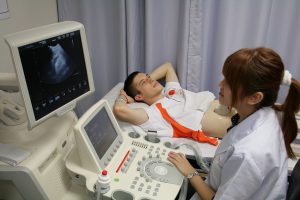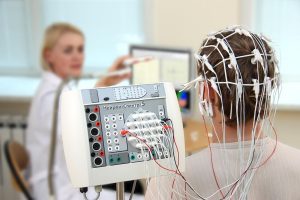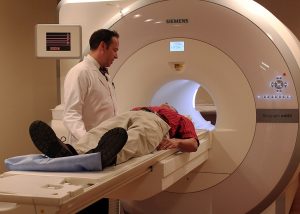9.4 Additional Healthcare Providers
There are additional healthcare providers that a patient might see in a hospital; however, these providers may be encountered less often because, in most cases, they are only intermittently involved in patient care. For example, a patient would see an MRI technologist only if they required an MRI, or a phlebotomist only if the patient required blood to be drawn. All healthcare providers are important for thorough and safe patient care.
Administrative support staff work in areas such as patient information, where they direct visitors to locations in the hospital, or patient registration, where they are responsible for admitting and registering patients in any department in the hospital (Alberta Health Services, 2022d).
Cardiology technologists perform diagnostic tests such as electrocardiograms (ECGs), stress testing, Holter monitor testing, ambulatory blood pressure testing, and pacemaker monitoring and programming.
Cardiovascular perfusionists are responsible for operating the heart-lung bypass machine during open heart surgery. They also monitor patients’ vitals and administer IV fluids and medications.
Diagnostic vascular technologists, also known as registered vascular sonographers, are technologists that image the vascular system.
Diagnostic medical sonographers use high-frequency sound waves to produce quality diagnostic images for a variety of ultrasound procedures such as the one seen in Fig. 9.11. They examine many parts of the body, including breasts, uterus and ovaries, testes, prostate gland, heart and blood vessels, and organs in the abdomen (Alberta Health Services, 2022a).

Electroneurophysiology technologists (ENPs) perform electroencephalograms (EEGs) and a few other specialized tests. During an EEG, the electrical activity of the brain is recorded through electrodes on the patient’s head, as can be seen in Fig. 9.12 (ACMDTT, 2022a).

Environmental services professionals are responsible for cleaning, sanitizing, and maintaining hospital units, clinical areas, and non-clinical treatment areas in the hospital. They clean rooms after patients are discharged and prepare them for new patients to be admitted.
Health information management professionals (HIM) organize and release information in accordance with the Health Information Act. Patients and their authorized representatives or third parties can access medical records from this department if they are authorized (Alberta Health Services, 2022b).
Hospital unit clerks (HUCs) are a vital part of the day-to-day operations on a hospital unit. They are responsible for transcribing and processing physician orders, including medication, laboratory, diagnostic imaging, and treatment orders. They also answer phones, book patients for tests and treatments, and maintain patient records and charts (Alberta Health Services, 2022c).
Magnetic resonance imaging (MRI) technologists produce diagnostic images by using equipment that generates radio waves and a strong magnetic field, as can be seen in Fig. 9.13. They use their extensive knowledge of anatomy, pathology, and physiology to obtain images and monitor patients during scans (ACMDTT, 2022e).

Medical laboratory technologists (MLTs) perform complex analyses of tissue, blood, and other body fluids.
Medical laboratory assistants (MLAs) spend the majority of their time processing samples and, in some unique cases, collecting them.
Medical radiological technologists use imaging, such as X-rays and computerized tomography (CT), to assist in the diagnosis and treatment of diseases (Ernstmeyer & Christman, 2021).
Nuclear medicine technologists use equipment to acquire scans of areas such as the thyroid, heart, bones, and kidneys. These images enable physicians to diagnose and monitor a patient’s response to various treatments. In order to complete a nuclear medicine scan, they must use some form of radioactive contrast material.
Patient food services staff provide quality food services to patients to support optimal patient outcomes and quality of life. Any changes to patient diets, nutrition requirements, or late admissions to the unit must be communicated to food services to ensure that patients receive the correct diets at their bedside (Alberta Health Services, 2022e).
Phlebotomists are professionals trained to draw blood, and when more than a few drops of blood are required, phlebotomists perform a venipuncture, typically using a vein in the arm (Betts et al., 2013). They also perform capillary sticks on fingers, as seen in Fig. 9.14, earlobes, or the heel of an infant when only a small quantity of blood is required. An arterial stick is collected from an artery and used to analyze blood gases. After collection, blood may be analyzed by a medical laboratory or possibly used for transfusions, donations, or research (Betts et al., 2013).

Porters transport patients throughout the hospital for tests or radiology treatments. They may transport patients in wheelchairs or on their beds or stretchers depending on the patients’ requirements.
Protective services professionals work in medical facilities to ensure the well-being of patients, healthcare professionals, and visitors. They prevent losses, damage, and disruptions in the hospital, and respond to crime, fire, accidents, and other incidents. They are also the department to call if there are any safety issues on a unit (Alberta Health Services, 2022f).
Prosthetists design, fit, and supply patients with artificial body parts such leg and arm prostheses. They also adjust prostheses to ensure proper fit, patient comfort, and optimal functioning (Ernstmeyer & Christman, 2021).
Recreation therapists (RTs) work with patients who have physical, mental, cognitive, or social limitations that can affect their ability to participate in leisure activities. The aim of the recreation therapist is to use recreation and leisure to create optimal health and well-being (Alberta Health Services, 2022g).
Radiation therapists are key members of a cancer treatment team (Alberta College of Medical Diagnostic and Therapeutic, 2022c). They are responsible for accurately planning and administering radiation treatments for cancer patients. They have expert knowledge in patient care and anatomy, as well as in radiation physics and radiation protection for the safe operation of the equipment. They are also knowledgeable about patient care considerations, spend time educating patients, and often, due to the ongoing nature of patient treatments, establish a ongoing therapeutic relationship with the patients they provide radiation treatments to (ACMDTT, 2022c).
Spiritual care professionals provide spiritual and emotional support to patients, their families, and healthcare professionals in the hospital (Ernstmeyer & Christman, 2021). They can assist patients and others from any religion or culture (Ernstmeyer & Christman, 2021).
Exercise
Attribution
Unless otherwise indicated, material on this page has been adapted from the following resource:
Carter, K., & Rutherford, M. (2020). Building a medical terminology foundation. eCampusOntario. https://ecampusontario.pressbooks.pub/medicalterminology/ licensed under CC BY 4.0
References
Alberta College of Medical Diagnostic and Therapeutic Technologists (ACMDTT). (2022a). Electroneurophysiology technology. https://acmdtt.com/about-us/specialties/electroneurophysiology-technology/
Alberta College of Medical Diagnostic and Therapeutic Technologists (ACMDTT). (2022b). Magnetic resonance technology. https://acmdtt.com/about-us/specialties/magnetic-resonance-technology/
Alberta College of Medical Diagnostic and Therapeutic Technologists (ACMDTT). (2022c). Radiological technology. https://acmdtt.com/about-us/specialties/radiological-technology/
Alberta Health Services. (2022a). Diagnostic sonographer. https://www.albertahealthservices.ca/careers/Page11703.aspx
Alberta Health Services. (2022b). Health information management. https://www.albertahealthservices.ca/careers/Page12300.aspx
Alberta Health Services. (2022c). Hospital unit clerk. https://www.albertahealthservices.ca/careers/Page12295.aspx
Alberta Health Services. (2022d). Information for patients & families. https://www.albertahealthservices.ca/info/Page12623.aspx
Alberta Health Services. (2022e). Patient food services. https://www.albertahealthservices.ca/nutrition/Page17382.aspx
Alberta Health Services. (2022f). Protective services officer. https://www.albertahealthservices.ca/careers/Page12341.aspx
Alberta Health Services. (2022g). Recreation therapist. https://www.albertahealthservices.ca/careers/Page11752.aspx
Betts, J. G., Young, K. A., Wise, J. A., Johnson, E., Poe, B., Kruse, D. H., Korol, O., Johnson, J. E., Womble, M., & DeSaix, P. (2013). Anatomy and physiology. OpenStax. https://openstax.org/details/books/anatomy-and-physiology licensed under CC BY 4.0
Ernstmeyer, K., & Christman, E. (Eds.). (2021). Nursing fundamentals. Chippewa Valley Technical College. https://wtcs.pressbooks.pub/nursingfundamentals is licensed under CC BY 4.0
Image Credits (images are listed in order of appearance)
Ultrasound vision by Aseev artem, CC BY-SA 3.0
EEG registration by Baburov, CC BY-SA 4.0
Fully Integrated Whole-body Simultaneous PET-MRI Device (24290532856) by NIH Image Gallery, Public Domain
Phlebotomy – drawing blood with a lancet by United States Agency for International Development (USAID), Public domain

